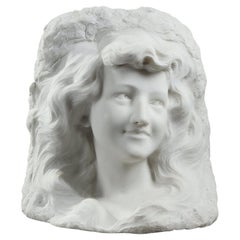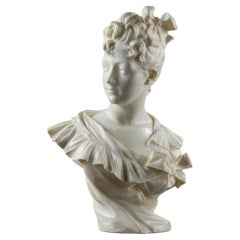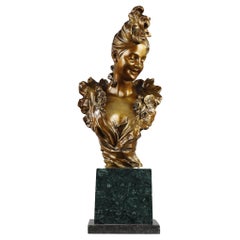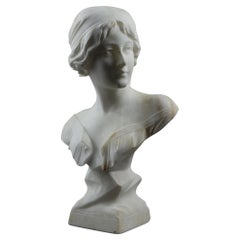Video Loading
Want more images or videos?
Request additional images or videos from the seller
1 of 16
Marble Bust: Cosette With Marianne's Phrygian Cap
Price:$3,946.70
$5,023.07List Price
About the Item
- Dimensions:Height: 20.87 in (53 cm)Width: 14.57 in (37 cm)Depth: 7.88 in (20 cm)
- Style:Art Nouveau (Of the Period)
- Materials and Techniques:
- Place of Origin:
- Period:
- Date of Manufacture:1900
- Condition:Wear consistent with age and use. In overall very good condition.
- Seller Location:Paris, FR
- Reference Number:Seller: 28081stDibs: LU2065322064482
About the Seller
4.9
Vetted Professional Seller
Every seller passes strict standards for authenticity and reliability
Established in 2001
1stDibs seller since 2016
324 sales on 1stDibs
Typical response time: 2 hours
Authenticity Guarantee
In the unlikely event there’s an issue with an item’s authenticity, contact us within 1 year for a full refund. DetailsMoney-Back Guarantee
If your item is not as described, is damaged in transit, or does not arrive, contact us within 7 days for a full refund. Details24-Hour Cancellation
You have a 24-hour grace period in which to reconsider your purchase, with no questions asked.Vetted Professional Sellers
Our world-class sellers must adhere to strict standards for service and quality, maintaining the integrity of our listings.Price-Match Guarantee
If you find that a seller listed the same item for a lower price elsewhere, we’ll match it.Trusted Global Delivery
Our best-in-class carrier network provides specialized shipping options worldwide, including custom delivery.You May Also Like
Plaster Bust of Marianne
Located in Atlanta, GA
Marianne is the embodiment of the French Republic. Marianne represents the permanent values that found her citizens' attachment to the Republic: "Liberty, Equality, Fraternity".
Category
Antique Late 19th Century Italian Classical Roman Busts
Materials
Plaster
French 19th Century Neo-Classical St. Bronze, Marble, & Ormolu Bust of Marianne
Located in West Palm Beach, FL
A stunning and most impressive French 19th century Neo-Classical st. patinated bronze, silvered bronze, ormolu, Rosso Verona and white Carrara marble bust of Marianne in full armor. The bust is raised by a thick Rosso Verona marble base with an elegant scalloped shape adorned with richly chased masks and swaging berried laurel garlands and centered by a striking fitted ormolu plaque...
Category
Antique 19th Century French Neoclassical Busts
Materials
Marble, Bronze, Ormolu
$44,500
H 27 in W 22 in D 13 in
French 19th Century Bronze and White Marble Bust of Marianne in Full Armor
Located in Los Angeles, CA
A French 19th century bronze and marble bust of Marianne in full armor. The nicely cast Baroque Revival brown patinated bronze and carved white marble figure of Marianne, the allegorical personification of the French Republic, presented in her militaristic guise, reminiscent of Minerva, wearing a Phrygian helmet and armored breastplate centered by winged male mask and with lion shoulder armor pads, all raised on a conforming black marble base. Circa: 1890-1900.
Marianne has been the national personification of the French Republic since the French Revolution, as a personification of liberty, equality, fraternity and reason, as well as a portrayal of the Goddess of Liberty.
Marianne is displayed in many places in France and holds a place of honor in town halls and law courts. She is depicted in the Triumph of the Republic, a bronze sculpture overlooking the Place de la Nation in Paris, as well as represented with another Parisian statue on the Place de la République. Her profile stands out on the official government logo of the country, appears on French euro coins and on French postage stamps. She was also featured on the former franc currency and is officially used on most government documents.
Marianne is a significant republican symbol; her French monarchist equivalent is often Joan of Arc. As a national icon Marianne represents opposition to monarchy and the championship of freedom and democracy against all forms of oppression. Other national symbols of Republican France include the tricolor flag, the national motto Liberté, Égalité, Fraternité, the national anthem "La Marseillaise", the coat of arms, and the official Great Seal of France. Marianne also wore a Cockade and a red Phrygian cap symbolizing Liberty.
Minerva and its pendant bust of Mars evoke the classicizing subjects, bust-length formats, and style that originated in France during the reign of Louis XIV (1643–1715) and that concurrently was popularized across Europe. The busts' simple forms, stiff poses, and solemn facial types are consistent with the late Baroque sculptures that were carved in Flanders during this period. In Flanders, especially in Antwerp and Brussels, sculpture and architectural decoration traditionally was carved using combinations of native black marble (noir belge), mottled red marble (rouge belge), and white marble or alabaster. The use of these stones in colorful counterpoint speaks most strongly to the busts’ Flemish origins.
The veneration of ideal heroes and heroines in ancient costume and arms took on extravagant form in the 17th century, with countless variations. Within this imaginative tradition, the identification of the pair as Minerva and Mars cannot be certain. The female bust, for example, could be identified as Bellona, Roman goddess of war, who is depicted in 17th and 18th century French paintings wearing flamboyantly plumed helmets and low-cut cuirasses that expose her breasts. Whatever their identities, the female and male warriors are portrayed as calm rather than bellicose beings. The sovereign pair does...
Category
Antique 19th Century French Baroque Revival Figurative Sculptures
Materials
Marble, Bronze
$24,950 Sale Price
27% Off
H 23.75 in W 20.63 in D 12 in
Maurice Bouval "Woman with Iris" Gilt Bronze & Marble Bust
By Maurice Bouval
Located in New York, NY
Maurice Bouval’s "Woman with Iris" is a nude gilt bronze bust of a woman. The woman’s hair clings to her face and body as if wet. The delicate sloping...
Category
Early 20th Century French Art Nouveau Busts
Materials
Marble, Bronze
Argentinian Marble Bust
Located in Round Top, TX
Argentinian Marble Bust of an important dude. Great quality marble and carving. Circa 1930.
Dimensions: roughly 15" H x 10" W x 7 3/8" D
Category
Early 20th Century Argentine Figurative Sculptures
Materials
Marble
Roman Marble Bust
Located in Houston, TX
A handsome large Italian marble bust sculpture of Roman soldier from the early 20th century. Measures: 33" tall.
Category
Early 20th Century Italian Art Deco Busts
Materials
Marble
Marble sculpture bust of Dionysius, Bust in Carrara marble, marble sculpture
Located in Rome, IT
Marble sculpture bust of Dionysius, Bust in Carrara marble, marble sculpture, Marble sculpture bust of Dionysius. ADDITIONAL PHOTOS, INFORMATION OF THE LOT AND QUOTE FOR SHIPPING COS...
Category
20th Century Italian Busts
Materials
Marble
$5,740 Sale Price
20% Off
H 31.5 in W 18.51 in D 18.12 in
Marble bust depicting classy woman with hat, 20th century italy
By Mice di rugiano domenico e c. s.n.c.
Located in Cantù, IT
Fine white marble bust depicting a young woman wearing a flower-adorned hat and dress decorated with a necklace and elegant garland of leaves. The work gracefully captures the aesthe...
Category
20th Century Italian Art Nouveau Busts
Materials
Marble
Late 19th Century Bust of Marianne - Ormolu Gilt Bronze
Located in Casteren, Noord-Brabant
Elegant and finely cast ormolu gilt bronze sculpture of Marianne, the enduring symbol of the French Republic. This 19th-century piece was made circa 1870 in France and features Maria...
Category
Antique 1870s French Napoleon III Busts
Materials
Brass, Bronze, Ormolu
$956
Free Shipping
H 15.36 in W 5.52 in D 5.52 in
Modern Marble Bust Sculpture
Located in New York, NY
Modern marble bust sculpture that is well designed. Would make a great addition to a modern interior.
Category
20th Century American Sculptures
Materials
Marble
More From This Seller
View AllBust of a young woman in Carrara marble, 19th century
Located in Paris, FR
Direct carving of a portrait of a smiling young woman in white Carrara marble from the Art Nouveau period. The sculptor uses a clever technique to bring out the face, allowing the fi...
Category
Antique 1890s French Art Nouveau Busts
Materials
Carrara Marble
Bust of a woman in marble, Henri Emile Allouard (1844-1929)
Located in Paris, FR
Bust of a beautiful woman in a corset held in place by a bow, with her face turned to the side exposing her profile. This beautiful marble sculpture is signed "Allouard" on the rever...
Category
Antique 1880s French Busts
Materials
Marble
Bust of a young woman from the Belle-époque, by Victor Léopold Bruyneel
By V. Bruyneel
Located in Paris, FR
Bust of a young woman from the Belle Epoque period, in bronze with a golden patina, resting on a green Alpine marble pedestal on a grey sainte Anne counter pedestal. The smiling youn...
Category
Antique Early 1900s French Art Nouveau Busts
Materials
Marble, Bronze
Alabaster bust of a young woman, signed Cyprien
Located in Paris, FR
Alabaster sculpture of a bust of a young woman with her hair held in a kerchief. Signed on the back: A. Cyprien.
Category
Antique Early 1900s French Busts
Materials
Alabaster
Small Bust Representing a Young Boy in Alabaster
Located in Paris, FR
Small alabaster bust representing a young boy wearing a drape. This very lively statuette shows him talking while turning to the left. This fine sculpture individualizes the child's hair strands...
Category
Antique 1880s French Busts
Materials
Alabaster
Terracotta bust sculpture by Jean-Baptiste Carpeaux
By Jean-Baptiste Carpeaux
Located in Paris, FR
Terracotta bust of L'Espiègle or La Rieuse aux pampres de vignes signed in point JBt CARPEAUX Carpeau property stamp, eagle stamp, numbered 1801. This model, representing Anna Foucart, the eldest daughter of Jean-Baptiste Foucart, a faithful friend of the artist, was created in 1865. Carpeaux himself distributed it in his studio on rue Boileau in Auteuil from 1868, and his heirs continued to publish it.
Related bibliography: Michel Poletti and Alain Richarme, Jean Baptiste Carpeaux...
Category
Antique 1870s French Busts
Materials
Terracotta
Recently Viewed
View AllMore Ways To Browse
Art Nouveau Marble Bust
Phrygian Cap
Large Marble Bust
Marianne France
Les Miserables
Marianne Bust
French Art Nouveau Bronze Busts
Antique Plaster Bust
Marmo Di Carrara
Large Bust Sculpture
Antique Gilt Bust
Antique Bust Statue
Chinese Heads
Ancient Egyptian Art
French Terracotta Busts
Roman Head
Display Head
19th Century Terracotta Bust



